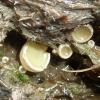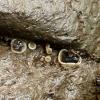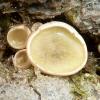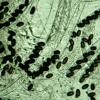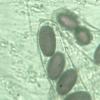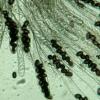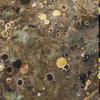
02-12-2025 18:59
This pair of ascos 2.5cm across were on recently b

02-12-2025 19:25
Buckwheat PeteHello, can anyone identify this hairy fungus growi

30-11-2025 12:53
 Edvin Johannesen
Edvin Johannesen
White short-stipitate apothecia found on thin twig

30-11-2025 10:47
 William Slosse
William Slosse
I recently found a collection of small Peziza sp.

27-11-2025 12:01
Thomas Læssøehttps://svampe.databasen.org/observations/10496727

27-11-2025 11:46
Thomas Læssøehttps://svampe.databasen.org/observations/10493918
Coprophilous Pezizaceae (2)
Esquivel-Rios Eduardo,
18-09-2012 21:18
Hans-Otto Baral,
18-09-2012 21:24

Re : Coprophilous Pezizaceae (2)
Dear Eduardo
I remember a big Ascobolus that I once found on horse dung in my garden. It was identified as A. scatigenus, but I never saw it again.
Here is the photo, and one from Panama by M. Piepenbring (left one) which I think might be the same species.
But it can well be that there exist several similar such species.
Zotto
I remember a big Ascobolus that I once found on horse dung in my garden. It was identified as A. scatigenus, but I never saw it again.
Here is the photo, and one from Panama by M. Piepenbring (left one) which I think might be the same species.
But it can well be that there exist several similar such species.
Zotto
Esquivel-Rios Eduardo,
18-09-2012 21:32
Re : Coprophilous Pezizaceae (2)
Yes, lokks identical, the inmature ascocarps cream-green and the mature black. Im chek Ascobolus.
Hans-Otto Baral,
18-09-2012 21:44

Re : Coprophilous Pezizaceae (2)
I remember that Meike said about the Panama fungus that the dark hymenia shoot their spores simultaneously upon touch or wind, thereby getting whitish within a blink of an eye! So the pale ones must not be immature.
Malcolm Greaves,
18-09-2012 23:45
Re : Coprophilous Pezizaceae (2)
I managed to capture this spore release if you are interested.
http://www.youtube.com/watch?v=ZvfVRfK83Oo?
Malcolm
http://www.youtube.com/watch?v=ZvfVRfK83Oo?
Malcolm
Hans-Otto Baral,
18-09-2012 23:49

Re : Coprophilous Pezizaceae (2)
Great! Is this real time or slow motion?
Malcolm Greaves,
19-09-2012 00:40
Re : Coprophilous Pezizaceae (2)
Real time.
Till Lohmeyer,
19-09-2012 16:34
Re : Coprophilous Pezizaceae (2)
It may well be Ascobolus scatigenus. There are hardly any other Ascoboli reaching that size. I've seen it quite frequently on horse dung in Australia. It seems to prefer the tropics or at least warmer regions. @ Zotto: I don't know of any other German find. What a garden!
Regards, Till
Hans-Otto Baral,
19-09-2012 16:40

Re : Coprophilous Pezizaceae (2)
Hi Till
It was dung from our neighbors, who keep horses. Possibly there was some inoculum introduced from the tropics, otherwise I cannot explain. Sometimes I think I have also introduced some fungi into my garden through specimens sent to me. But this Ascobolus was long before Guy made his trips to Australia...
Zotto
It was dung from our neighbors, who keep horses. Possibly there was some inoculum introduced from the tropics, otherwise I cannot explain. Sometimes I think I have also introduced some fungi into my garden through specimens sent to me. But this Ascobolus was long before Guy made his trips to Australia...
Zotto
